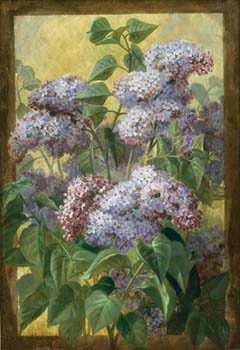Lilas (Lilacs)
- n.d.
- Victor Bussière (French 1836-1905)
- Oil on canvas
55.0 x 38.0 cm., 21-3/4 x 15"
- Catherine Carter Goebel, Paul A. Anderson Chair in the Arts Purchase, Paul A. Anderson Art History Collection, Augustana College 2000.35

Essay by Amy DeLamoreaux, Class of 2001
Little is known about Victor Bussière. So little, in fact, that he seems only to be mentioned as father to his better known painter-son, Gaston Bussière (1862-1929). We do know, however, that this work was probably atypical of Victor Bussière's repertoire since he was trained and worked as an interior mural painter in Paris and Macon during the mid-nineteenth century (Bussière 22). We can assume, then, that Victor probably painted Lilacs during or near the end of his apprenticeship. Given this, it is quite possible that this painting may have determined the direction of Victor's career.
Lilacs was painted at a time when still life subjects were still considered the lowest form of artistic representation by the French Salons. In 1840, still life was even mockingly described as "the hors d'oeuvre of painting" for its use of flowers and fruit as subject matter (Hardouin-Fugier 97). Paintings like this were purchased frequently to adorn dining rooms and were rarely hung in gallery exhibitions. Still life artists of the time, however, heralded the genre as a combination of the studies of nature, reality and light. Eventually this genre began to gain popularity and was increasingly shown in Salons. The French term for still life, nature morte, literally meaning dead nature, appropriately names the art form for its fixation on transient and decomposing subject matter.
Perhaps, then, Lilacs represents Victor Bussière as a still life artist-to-be who chose another path in his artistic career to avoid the difficulty of establishing himself in a genre surrounded by much criticism and debate. Yet Bussière successfully mastered the play of light on nature in this work, showing the effect of sunlight as it hits the plant's shiny green leaves. He also made use of still life's fundamental quality of decay by representing the flowers in different stages of growth—displaying both buds and full booms. Particularly beautiful is Bussière's use of trompe l'oeil (illusionism) and atmospheric perspective, making the flowers look almost as if they are growing into the viewer's personal space through an open window. The blossoms have such tactile quality that they offer their audience a visual bouquet.
